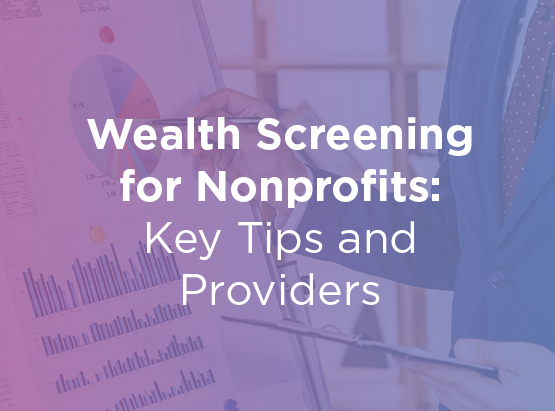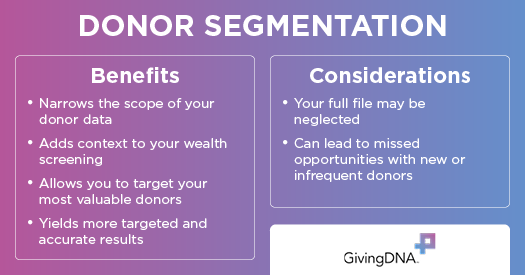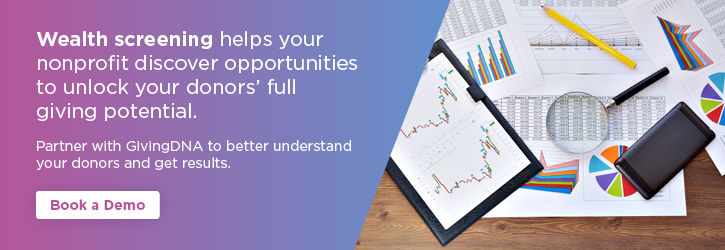Wealth Screening for Nonprofits: Key Tips and Providers

As a nonprofit professional, one of your most important resources is your donor data. Well-organized donor data is key to maintaining strong donor relationships and connecting with supporters to motivate them to reach their full giving potential. Nonprofits now are data collectors, like it or not.
In addition to your first-party data on your donors, your nonprofit should conduct regular wealth screenings to append third-party data and gain additional valuable insights. Wealth screening allows nonprofits to make the most of their limited resources by identifying promising major gift opportunities and planned giving prospects quickly.
In this guide, we’ll discuss how your organization can maximize fundraising success with wealth screening and answer these basic questions:
- What is wealth screening?
- What are some wealth screening tips?
- What are the best wealth screening tools and resources?
At GivingDNA, we believe in helping nonprofits turn their valuable data into action. Powered by Pursuant’s more than 20 years of experience in nonprofit marketing, GivingDNA’s fundraising, wealth screening, and data analytics tool is equipped to help your nonprofit uncover insights that drive success in all parts of its fundraising strategy.
Before choosing the perfect wealth screening software, it’s best to have a deep understanding of what wealth screening entails. Let’s get started by defining wealth screening.
What is wealth screening?

Wealth screening is the process of learning more about your supporters and prospects to determine their capacity to give to your organization.
Wealth screening may sound similar to prospect research, or the process of uncovering large amounts of detailed data about prospective major donors, including their backgrounds, past philanthropic behaviors, and philanthropic motivations. Both look at third-party data to identify your prospects’ giving affinity and propensity by identifying their connection to your cause and how likely they are to give. Additionally, they measure current and prospective donors’ capacity to give using wealth indicators.
The biggest difference between the two is that prospect research is very time-consuming and manual, requiring your team to do hours of research potentially to find and validate data. A wealth screening can look at your entire file and append similar data en masse to your file. Ultimately, time is money, so being able to identify those top prospects as quickly and efficiently as possible is why wealth screenings are gaining in popularity.
Some of the data a wealth screening can give your organization access to is wealth indicators. These are characteristics of your current or prospective donors that signal their financial capacity to give. A few of the most common wealth indicators include:
- Real estate ownership
- Stock ownership
- Business affiliations
- Political contributions
- Net worth
The best way to conduct wealth screening is by using a wealth profiling tool to analyze your donor data. These tools should allow you to instantly identify top donors, pinpoint wealth indicators, and create easily digestible data visualizations. They should also help you prioritize donors for all levels of your fundraising strategy. You can maximize the success of your wealth screening process by combining a wealth profiling tool with wealth screening tips and best practices.
What are some wealth screening tips?
We operate in a data-driven world. Every organization, whether it’s a for-profit business or a nonprofit organization, uses data to successfully navigate its industry. Wealth screening provides data that can be immensely valuable to your nonprofit when put to use.
Even if your nonprofit has an extensive donor database, you may need to put in additional work before turning it over to a wealth screening tool or service. Clean, well-managed data ensures the most accurate results, leading you to the most promising donors.
To cultivate a dataset that will have compelling results, your nonprofit should follow data hygiene best practices like developing standardized data entry methods, regularly backing up files, and removing duplicate records. However, these tasks can be difficult to manage on your own, especially if you have hundreds or thousands of donor files. Choosing a wealth screening tool like GivingDNA that identifies duplicate records for you helps support healthy data so you can quickly access the most accurate results possible.
Combine internal and external data.
During a traditional wealth screening, nonprofits use external, appended data (like employer data or stock holdings) to learn more about their donors’ financial giving capacity. However, to take full advantage of this data, it’s important to combine it with internal data that highlights exactly how donors interact with your nonprofit. As you look for the perfect wealth screening tool, prioritize those that enrich traditional data appends with internal donor data.
Without examining internal data, you could miss important patterns in your donors’ behavior. With a tool that leverages both types of data, you can identify the donors who are giving the most and their reasons and motivations for contributing. On the flip side, you can also find the donors who aren’t giving or are at risk of lapsing and proactively re-engage them.
Another benefit of screening both internal and external data is that you can learn the best ways to communicate with donors. Without data about their demographics and how they got involved with your organization in the past, for instance, you may target them through the wrong media channel or use language that makes them uncomfortable. Make the messages you send to donors impactful and inspiring by appealing to their unique motivations for giving.
Screen frequently.
Traditionally, wealth screening tools limit nonprofits to one screening every two to five years due to the large amounts of data required to perform the screenings. This can limit your nonprofit to stale data that leads to missed opportunities.
To get the most out of wealth screening, your organization needs a tool that allows it to screen regularly. New donor activity occurs on a monthly, weekly, and even daily basis, meaning new opportunities can appear just as often. To identify and act on those opportunities, look for a wealth screening tool that allows you to screen at least once a month.
Segment your donors.

Depending on the size of your donor base, screening your donors can be a very extensive and costly process. Narrowing the scope of this data can help you maximize effectiveness by giving you more targeted (and more accurate) results.
Let’s say you want to create a segment made up of your most loyal donors. These include those who have supported your nonprofit the longest, donate most often, and seek out other involvement opportunities. Within this smaller subset of donors, begin analyzing typical wealth and philanthropic markers.
Segmentation gives you deeper insight into your donors’ behavior by adding additional context to the results of your wealth screening. By looking at a segment of loyal donors, you already know that these are your most dedicated supporters. Therefore, they will likely be receptive to your messaging.
When segmenting your donors, be sure not to limit your audience. There are multiple ways to determine which of your constituents are valuable, and creating multiple segments can help you identify diverse fundraising opportunities. If you only reference segments of donors who already strongly identify with your organization, you could miss chances to connect on a deeper level with donors who have never donated or are at risk of lapsing. Be sure to regularly screen your entire file to gain a comprehensive understanding of all of your donors.
Know the limitations of wealth screening.
Wealth screening can provide your team with the data they need to reach your fundraising goals and gain a deeper understanding of its donors. But with these benefits come certain limitations. Understanding the limitations of the process is key to truly maximizing wealth screening’s benefits.
Wealth screening alone doesn’t give you a full picture of your donors’ unique circumstances. For example, you may have two donors with virtually equal household incomes, real estate holdings, and stock ownership. However, after investigating further, you might find that due to other expenses like paying for their child’s college education, one of these donors is less likely to make a transformative gift.
This scenario demonstrates why data alone isn't a guarantee that donors will contribute major gifts or even continue to give at all. After all, not all wealthy prospects are philanthropic, and those that are may not prioritize giving to your cause. Incorporating other information like past giving and philanthropic tendencies along with having personal conversations with prospective major donors can help fill in the gaps after your initial wealth screening.
Reference past philanthropic behaviors.
While wealth screening helps you specifically identify wealth markers, it’s up to your team to investigate a donor’s propensity to give and affinity to support your mission. Combining wealth screening with detailed prospect research can help you find the most promising prospects. Specifically, identifying past philanthropic indicators can help you determine which prospective donors have a history of involvement with mission-driven organizations.
Philanthropic indicators can provide insight into your donors’ philanthropic habits. These indicators help uncover your donors’ motivations for giving as well as the causes they are most passionate about. For example, you might note that one of your donors gives to a few other nonprofits with a similar mission to yours, indicating they may have a deep, personal motivation for their involvement with your organization. Donors who have both a high capacity to give and a potential affinity for your cause are often your strongest major gifts candidates.
These indicators can include:
- Past charitable giving. Note any instances of past charitable giving to your nonprofit or other charitable organizations. Be sure to analyze the details of these contributions, including the recency, frequency, and size of their donations.
- Past involvement with mission-driven organizations. Financial contributions aren’t the only way to measure your supporters’ philanthropic involvement. Did the donor serve on another nonprofit’s board? Did they volunteer with another organization? Did they advocate for a charitable cause? These factors can indicate how invested they are in your cause, therefore showing a potential willingness to make a significant donation.
Wealth alone doesn’t guarantee donors or prospects are interested in contributing mid-level or major gifts. Incorporating data points like philanthropic indicators widen the lens of your wealth screening to give you a clearer picture of what drives your donors to give.
What are the best wealth screening tools and resources?
In addition to following basic wealth screening tips, one of the best ways to maximize your success is to use wealth screening tools. Because wealth screening deals with massive amounts of data, it can be difficult to sift through and draw conclusions from the information on your own. Using a tool or resource can help you effectively screen your donors for wealth indicators to identify your prospective major giving candidates and bring you closer to reaching your nonprofit’s fundraising goals.
GivingDNA
Built to help nonprofits discover and identify their most valuable donors, GivingDNA is a tool that combines fundraising analytics, data visualization, and wealth profiling to give you the insights you need to take action and reach your fundraising goals.
GivingDNA centers data at its core, helping its users identify and carry out data-driven fundraising decisions. The tool combines information from data points like donor demographics, behaviors, and engagement to reveal who your donors are and what motivates them to get involved.
GivingDNA’s partnership with Windfall combines Windfall’s rich dataset with GivingDNA’s powerful visualizations and segmentation tools. Through this integration, GivingDNA can bring you the best possible net worth predictors with dependable data. Now, you can update data weekly to quickly develop actionable insights and targeted segments.

This platform’s features include:
- A secure hub with a visualized, dynamic interface
- Interactive dashboards
- Behavioral insights, buying patterns, and philanthropic priorities
- Prospect identification and prioritization
- Segmentation by channel preference, motivation, and more
These features were designed with the unique struggles nonprofits face in mind. Intended to make your life as a nonprofit professional easier, GivingDNA works to address common fundraising pain points by:
- Being more effective than traditional fundraising methods. Let’s say you just spent seemingly endless hours calling up countless donors only to get just a few yeses. With GivingDNA, you can trim your list to include only the donors who are most willing to contribute to your cause. By working with a refined list of donors, you’ll improve the results of these calls while doing less work overall.
- Providing more direction. GivingDNA provides the insights you need to guide your next steps to secure major donations, putting you well on your way to completing your goals.
- Remedying burnout. In roles like development directors, high turnover is common due to the near-constant pressure to deliver much-needed funds to nonprofits. Without a tool to prioritize prospects and gather actionable insights, many development directors and fundraisers feel helpless if funding starts to stagnate. Tools like GivingDNA can help you identify new, untapped audiences that will breathe new life, and new funds, into your fundraising approach.
While GivingDNA is a fantastic tool for identifying major gift opportunities, it has a range of features to help will all levels of the giving pyramid. From annual giving to mid-level and sustaining giving, GivingDNA can transform every part of your fundraising strategy. To learn more about GivingDNA and see the software in action, request a demo today!
NPOInfo
NPOInfo is a data appending service that can be used to fill in the gaps in existing donor databases. They serve a range of organizations including nonprofits, educational institutions, healthcare organizations, and associations.
NPOInfo offers the following services:
- Employer appends
- Email appends
- Phone number appends
- Date of birth appends
- Address appends
Having accurate data is a key piece of the fundraising puzzle. You wouldn’t want to perform a wealth screening based on stale data about where your constituents live and work as these factors can be crucial to gaining valuable insights about wealth. It’s expected that your donors will move, switch jobs, and encounter other life changes that should be reflected in your data.
By appending missing data, you can gain more accurate wealth screening results.
U.S. Securities and Exchange Commission
The U.S. Securities and Exchange Commission (SEC.gov) exists to protect stock investors, keep stock markets fair, and facilitate capital formation. Your organization can also use this resource to learn more about your constituents’ stock holdings.
You can use this government database to identify your current and prospective donors’ stock holdings. Donors’ stock portfolios give you a window into their wealth, helping you piece together a more comprehensive story about their overall wealth. Keep in mind that you will only be able to view data about the ownership of public companies on SEC.gov, and you will need to assess how much of your donors’ total wealth is invested in stocks.
Federal Election Commission
The Federal Election Commission (FEC.gov) is another government database that can help you gain insights into your donors’ wealth. This database contains information about prospective and current donors’ political donations.
Political giving can help you understand how capable your prospects are of giving and how likely they are to give. Based on the size of the donations donors make, you can roughly determine what their financial capacities are. These donations can also give you a sense of your donors’ political leanings and ideologies which can be a powerful predictor of how likely they are to donate to your organization.
Wrapping Up
Wealth screening is a powerful way to find donors willing to make impactful contributions to your organization. To get the most out of your wealth screening process, you’ll need to invest in a robust tool that can help you understand your donors’ behaviors and motivations. GivingDNA offers a comprehensive, all-in-one fundraising analytics, data visualization, and wealth profiling tool that simplifies the screening process so you can make data-driven fundraising decisions.
To learn more about how GivingDNA can empower your team, book a demo today.


